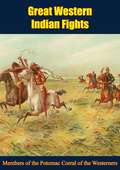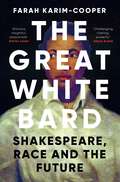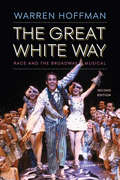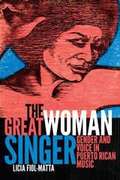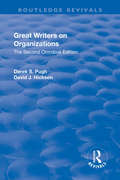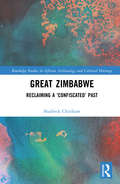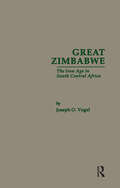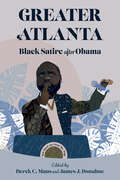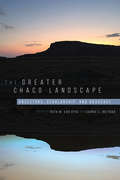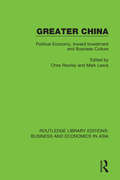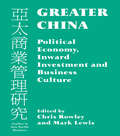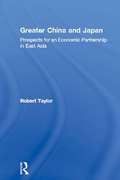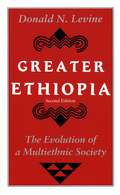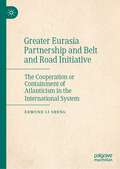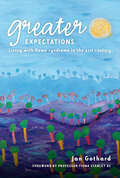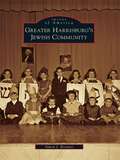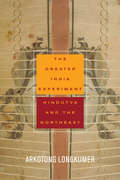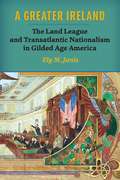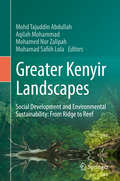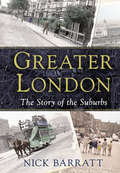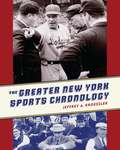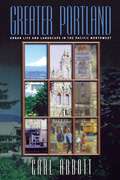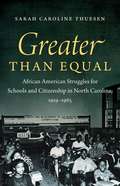- Table View
- List View
Great Western Indian Fights
by Members of the Potomac Corral of the WesternersFrom 1832 to 1891 the states from the Great Lakes west to Oregon and south to Mexico saw scenes of massacre, bloody rout, ambush, fire, and pillage as the great Indian tribes-Blackfoot, Cheyenne, Sioux, Arapaho, Modoc, and Apache-fought desperately to turn back the invading white men.Recreated in this volume, original published in 1960, are twenty-odd battles crucial in the opening of the American West to white settlement. Among the battles included here are the Pierre’s Hole fight, the battle of Bandera Pass, the battle of Pyramid Lake, the battle of Wood Lake, the Canyon de Chelly rout, the battles of Adobe Walls, the Fetterman, Hayfield, and Wagon Box fights, the fight at Beecher Island, the battle of the Washita, the battles of Massacre Canyon and Palo Duro Canyon, the battle of the Rosebud, the battle of the Little Bighorn, the Dull Knife massacre, and the final, tragic battle at Wounded Knee.“A fine guide to the conflict that transpired across the wide Missouri.”—San Francisco Sunday Chronicle“An excellent account of most of the major fights between the white man and the Indian in…the western part of the United States.”—Library Journal“Two dozen of the most celebrated and hair-raising Indian fights on record. Good, solid reading, and a whole peck of it.”—New York Times Book Review
The Great White Bard: How to Love Shakespeare While Talking About Race
by Farah Karim-CooperSHAKESPEARE: increasingly irrelevant or lone literary genius of the Western canon?'Powerful and illuminating' James Shapiro, author of 1599: A Year in the Life of William Shakespeare, winner of the Baillie Gifford 'Winner of Winners' 2023 Professor Farah Karim-Cooper grew up loving the Bard, perhaps because Romeo and Juliet felt Pakistani to her. But why was being white as a &‘snowy dove&’ essential to Juliet&’s beauty? Combining piercing analysis of race, gender and otherness in beloved plays from Othello to The Tempest with a radical reappraisal of Elizabethan London, The Great White Bard entreats us neither to idealise nor to fossilise Shakespeare but instead to look him in the eye and reckon with the discomforts of his plays, playhouses and society. If we persist in reading Shakespeare as representative of only one group, as the very pinnacle of the white Western canon, then he will truly be in peril. But if we dare to bring Shakespeare down from his plinth, we might unveil a playwright for the twenty-first century. We might expand and enrich his extraordinary legacy. We might even fall in love with him all over again. *** A TIME MAGAZINE BOOK OF THE YEAR 2023 'Insightful, passionate, piled with facts and has a warm, infectious love for theatre and Shakespeare running through every chapter.' ADRIAN LESTER, CBE 'Dive in and your whole cultural landscape will be refreshed and reframed... A challenging, riveting read, The Great White Bard reminds us how powerful the stories we tell can be on our lives.' ADJOA ANDOH 'Vivid… a thorough analysis but also a kind of love letter… Karim-Cooper sees Shakespeare as holding a mirror to this society, with his plays interrogating live issues around race, identity and the colonial enterprise… Her arguments come to feel essential and should be absorbed by every theatre director, writer, critic, interested in finding new ways into the work.&’ GUARDIAN 'There are plenty of books on Shakespeare: but this one is different. This is Shakespeare as we&’ve (most of us) never been willing to see him – and the works emerge from the analysis as newly complicit, powerful and yet recuperative.' EMMA SMITH, AUTHOR OF PORTABLE MAGIC
The Great White Way: Race and the Broadway Musical
by Warren HoffmanBroadway musicals are one of America’s most beloved art forms and play to millions of people each year. But what do these shows, which are often thought to be just frothy entertainment, really have to say about our country and who we are as a nation? Now in a new second edition, The Great White Way is the first book to reveal the racial politics, content, and subtexts that have haunted musicals for almost one hundred years from Show Boat (1927) to Hamilton (2015). This revised edition includes a new introduction and conclusion, updated chapters, as well as a brand-new chapter that looks at the blockbuster musicals The Book of Mormon and Hamilton. Musicals mirror their time periods and reflect the political and social issues of their day. Warren Hoffman investigates the thematic content of the Broadway musical and considers how musicals work on a structural level, allowing them to simultaneously present and hide their racial agendas in plain view of their audiences. While the musical is informed by the cultural contributions of African Americans and Jewish immigrants, Hoffman argues that ultimately the history of the American musical is the history of white identity in the United States. Presented chronologically, The Great White Way shows how perceptions of race altered over time and how musicals dealt with those changes. Hoffman focuses first on shows leading up to and comprising the Golden Age of Broadway (1927–1960s), then turns his attention to the revivals and nostalgic vehicles that defined the final quarter of the twentieth century. He offers entirely new and surprising takes on shows from the American musical canon—Show Boat (1927), Oklahoma! (1943), Annie Get Your Gun (1946), The Music Man (1957), West Side Story (1957), A Chorus Line (1975), and 42nd Street (1980), among others. In addition to a new chapter on Hamilton and The Book of Mormon, this revised edition brings The Great White Way fully into the twenty-first century with an examination of jukebox musicals and the role of off-Broadway and regional theaters in the development of the American musical. New archival research on the creators who produced and wrote these shows, including Leonard Bernstein, Jerome Robbins, Stephen Sondheim, and Edward Kleban, will have theater fans and scholars rethinking forever how they view this popular American entertainment.
The Great Woman Singer: Gender and Voice in Puerto Rican Music
by Licia Fiol-MattaLicia Fiol-Matta traces the careers of four iconic Puerto Rican singers—Myrta Silva, Ruth Fernández, Ernestina Reyes, and Lucecita Benítez—to explore how their voices and performance style transform the possibilities for comprehending the figure of the woman singer. Fiol-Matta shows how these musicians, despite seemingly intractable demands to represent gender norms, exercised their artistic and political agency by challenging expectations of how they should look, sound, and act. Fiol-Matta also breaks with conceptualizations of the female pop voice as spontaneous and intuitive, interrogating the notion of "the great woman singer" to deploy her concept of the "thinking voice"—an event of music, voice, and listening that rewrites dominant narratives. Anchored in the work of Lacan, Foucault, and others, Fiol-Matta's theorization of voice and gender in The Great Woman Singer makes accessible the singing voice's conceptual dimensions while revealing a dynamic archive of Puerto Rican and Latin American popular music.
Great Writers on Organizations: The Second Omnibus Edition
by Derek S Pugh David J HicksonThis title was first published in 2000: A collection of the thoughts of many great writers on organizations. These writers are from a variety of different backgrounds. Some draw upon their expertise as practising managers, some on their knowledge of rational and local government administration, and some on the findings of their research work. All have attempted to draw together information and distil theories about how organizations function and how they should be managed. The volume seeks to provide a general overview of the field, and does not provide critical analysis of the views provided.
Great Zimbabwe: Reclaiming a ‘Confiscated’ Past (Routledge Studies in African Archaeology and Cultural Heritage)
by Shadreck ChirikureConditioned by local ways of knowing and doing, Great Zimbabwe develops a new interpretation of the famous World Heritage site of Great Zimbabwe. It combines archaeological knowledge, including recent material from the author’s excavations, with native concepts and philosophies. Working from a large data set has made it possible, for the first time, to develop an archaeology of Great Zimbabwe that is informed by finds and observations from the entire site and wider landscape. In so doing, the book strongly contributes towards decolonising African and world archaeology. Written in an accessible manner, the book is aimed at undergraduate students, graduate students, and practicing archaeologists both in Africa and across the globe. The book will also make contributions to the broader field such as African Studies, African History, and World Archaeology through its emphasis on developing synergies between local ways of knowing and the archaeology.
Great Zimbabwe: The Iron Age of South Central Africa
by Joseph O. VogelFirst Published in 1994. This research guide was written as a comprehensive, though by no means exhaustive, survey of the literature pertinent to studying the indigenous complex societies of south central Africa. Although the paramount focus of the compilation was the archaeology of Great Zimbabwe, the author has drawn from a broad geographical area and a wider period of time than that usually associated with Zimbabwean culture in order to demonstrate the cultural background for the growth of monumental trading towns in south central Africa.
Greater Atlanta: Black Satire after Obama
by Derek C. Maus and James J. DonahueContributions by GerShun Avilez, Lola Boorman, Thomas Britt, John Brooks, Phillip James Martinez Cortes, Derek DiMatteo, Tikenya Foster-Singletary, Alexandra Glavanakova, Erica-Brittany Horhn, Matthias Klestil, Abigail Jinju Lee, Derek C. Maus, Danielle Fuentes Morgan, Derek Conrad Murray, Kinohi Nishikawa, Sarah O'Brien, Keyana Parks, and Emily Ruth RutterThe seventeen essays in Greater Atlanta: Black Satire after Obama collectively argue that in the years after the widespread hopefulness surrounding Barack Obama’s election as president waned, Black satire began to reveal a profound shift in US culture. Using the four seasons of the FX television show Atlanta (2016–22) as a springboard, the collection examines more than a dozen novels, films, and television shows that together reveal the ways in which Black satire has developed in response to contemporary cultural dynamics. Contributors reveal increased scorn toward self-proclaimed allies in the existential struggle still facing African Americans today.Having started its production within a few weeks of Donald Trump’s (in)famous escalator ride in 2015, Atlanta in many ways is the perfect commentary on the absurdities of the contemporary cultural moment. The series exemplifies a significant development in contemporary Black satire, which largely eschews expectations of reform and instead offers an exasperated self-affirmation that echoes the declaration that Black Lives Matter.Given anti-Black racism’s lengthy history, overt stimuli for outrage have predictably commanded African American satirists’ attention through the years. However, more recent works emphasize the willful ignorance underlying that history. As the volume shows, this has led to the exposure of performative allyship, virtue signaling, slacktivism, and other duplicitous forms of purported support as empty, oblivious gestures that ultimately harm African Americans as grievously as unconcealed bigotry.
The Greater Chaco Landscape: Ancestors, Scholarship, and Advocacy
by Ruth M. Van Dyke Carrie C. HeitmanSince the mid-1970s, government agencies, scholars, tribes, and private industries have attempted to navigate potential conflicts involving energy development, Chacoan archaeological study, and preservation across the San Juan Basin. The Greater Chaco Landscape examines both the imminent threat posed by energy extraction and new ways of understanding Chaco Canyon and Chaco-era great houses and associated communities from southeast Utah to west-central New Mexico in the context of landscape archaeology. Contributors analyze many different dimensions of the Chacoan landscape and present the most effective, innovative, and respectful means of studying them, focusing on the significance of thousand-year-old farming practices; connections between early great houses outside the canyon and the rise of power inside it; changes to Chaco’s roads over time as observed in aerial imagery; rock art throughout the greater Chaco area; respectful methods of examining shrines, crescents, herraduras, stone circles, cairns, and other landscape features in collaboration with Indigenous colleagues; sensory experiences of ancient Chacoans via study of the sightlines and soundscapes of several outlier communities; and current legal, technical, and administrative challenges and options concerning preservation of the landscape. An unusually innovative and timely volume that will be available both in print and online, with the online edition incorporating video chapters presented by Acoma, Diné, Zuni, and Hopi cultural experts filmed on location in Chaco Canyon, The Greater Chaco Landscape is a creative collaboration with Native voices that will be a case study for archaeologists and others working on heritage management issues across the globe. It will be of interest to archaeologists specializing in Chaco and the Southwest, interested in remote sensing and geophysical landscape-level investigations, and working on landscape preservation and phenomenological investigations such as viewscapes and soundscapes. Contributors: R. Kyle Bocinsky, G. B. Cornucopia, Timothy de Smet, Sean Field, Richard A. Friedman, Dennis Gilpin, Presley Haskie, Tristan Joe, Stephen H. Lekson, Thomas Lincoln, Michael P. Marshall, Terrance Outah, Georgiana Pongyesva, Curtis Quam, Paul F. Reed, Octavius Seowtewa, Anna Sofaer, Julian Thomas, William B. Tsosie Jr., Phillip Tuwaletstiwa, Ernest M. Vallo Jr., Carla R. Van West, Ronald Wadsworth, Robert S. Weiner, Thomas C. Windes, Denise Yazzie, Eurick Yazzie
Greater China: Political Economy, Inward Investment and Business Culture (Routledge Library Editions: Business and Economics in Asia #15)
by Chris Rowley Mark LewisThis book, first published in 1996, focuses on the possible (but problematic) emergence of a so-called ‘Greater China’ encompassing mainland China, Taiwan and Hong Kong, and the economic reforms, inward investment, spatial disparities, and changes to business culture that would ensue. The similarities, differences, underpinnings, results and prospects for the future of Greater China are analysed in close detail in the chapters collected here.
Greater China: Political Economy, Inward Investment and Business Culture (Routledge Library Editions: Business And Economics In Asia Ser. #15)
by Chris Rowley Mark LewisA critical analysis of the reasons underlying the emergence of the Asia Pacific as an economic superpower and the need for judicious evaluation of the likely shape and character of the region's future development. The aim of this collection is to illuminate key areas of debate concerning the People's Republic of China, Hong Kong and Taiwan here collectively referred to as Greater China in the belief that the destiny of the Pacific Rim as a whole will be decisively influenced by economic and political developments in this particular region.
Greater China and Japan: Prospects for an Economic Partnership in East Asia (The University of Sheffield/Routledge Japanese Studies Series)
by Robert TaylorContemporary relations between Greater China and Japan have been conditioned both by differing responses to the impact of Western colonialism during the mid-nineteenth century and the legacy of the Cold War. There are mutual suspicions: the Chinese fear of a Japanese military revival and the Japanese concern over increasing Chinese economic competition and territorial ambitions.Robert Taylor recognises the mistrust in Sino-Japanese relations, but also sees shared advantages in this traditionally adversarial relationship. The Chinese are currently modelling their economic strategy on Japan's developmental experience, even though China's policies and institutions have distinctive features and differing agendas. The study also examines the growing momentum towards sub-regional integration; rivalry between Greater China and Japan is giving way to competition between regional economic blocks and corporate entities.Greater China and Japan explores the ambiguous relationship between the two countries and states that its development is crucial to the future of the region in the twenty-first century.
Greater Ethiopia: The Evolution of Multiethnic Society
by Donald N. LevineGreater Ethiopia combines history, anthropology, and sociology to answer two major questions. Why did Ethiopia remain independent under the onslaught of European expansionism while other African political entities were colonized? And why must Ethiopia be considered a single cultural region despite its political, religious, and linguistic diversity? Donald Levine's interdisciplinary study makes a substantial contribution both to Ethiopian interpretive history and to sociological analysis. In his new preface, Levine examines Ethiopia since the overthrow of the monarchy in the 1970s. "Ethiopian scholarship is in Professor Levine's debt. . . . He has performed an important task with panache, urbanity, and learning. "—Edward Ullendorff, Times Literary Supplement "Upon rereading this book, it strikes the reader how broad in scope, how innovative in approach, and how stimulating in arguments this book was when it came out. . . . In the past twenty years it has inspired anthropological and historical research, stimulated theoretical debate about Ethiopia's cultural and historical development, and given the impetus to modern political thinking about the complexities and challenges of Ethiopia as a country. The text thus easily remains an absolute must for any Ethiopianist scholar to read and digest. "-J. Abbink, Journal of Modern African Studies
Greater Ethiopia: The Evolution of a Multiethnic Society
by Donald N. LevineGreater Ethiopia combines history, anthropology, and sociology to answer two major questions. Why did Ethiopia remain independent under the onslaught of European expansionism while other African political entities were colonized? And why must Ethiopia be considered a single cultural region despite its political, religious, and linguistic diversity? Donald Levine's interdisciplinary study makes a substantial contribution both to Ethiopian interpretive history and to sociological analysis. In his new preface, Levine examines Ethiopia since the overthrow of the monarchy in the 1970s. "Ethiopian scholarship is in Professor Levine's debt. . . . He has performed an important task with panache, urbanity, and learning."—Edward Ullendorff, Times Literary Supplement "Upon rereading this book, it strikes the reader how broad in scope, how innovative in approach, and how stimulating in arguments this book was when it came out. . . . In the past twenty years it has inspired anthropological and historical research, stimulated theoretical debate about Ethiopia's cultural and historical development, and given the impetus to modern political thinking about the complexities and challenges of Ethiopia as a country. The text thus easily remains an absolute must for any Ethiopianist scholar to read and digest."-J. Abbink, Journal of Modern African Studies
Greater Eurasia Partnership and Belt and Road Initiative: The Cooperation or Containment of Atlanticism in the International System
by Edmund Li ShengIn this book, Eurasia will be discussed in the context of the Greater Eurasian Partnership proposed by Russia, the “eastward” transformations spurred by Neo-Eurasianism and the Greater Eurasian Partnership, and cooperation with China through the BRI, while related countries of Atlanticism was used to described the U.S., Europe, and their allies. The Greater Eurasian Partnership proposed by Russia is an initiative with specific diplomatic considerations, economic development strategies, and geopolitical implications. The initiative represents an attempt by Russia to shift foreign policy thinking, which has traditionally focused on alignment with the U.S. and the West. The Greater Eurasian Partnership contains both short-term strategies to cope with Western pressure and long-term strategic goals for building a new international and regional order. What this portends for the future of Sino-Russian relations is of interest to geopoliticians, economists and journalists.
Greater Expectations: Living with Down Syndrome in the 21st Century
by Jan Gothard Professor Fiona StanleyBased on more than 60 personal interviews and supported by scholarly research, this book shows the varied attitudes and approaches that make up the rich experience of living with disability in a changing society. Covering Down syndrome from conception to old age, this historical analysis touches upon a variety of themes, including education, friendship, health, recreation, sexuality, employment, and independence. This moving, partly autobiographical account is a must read for all parents, teachers, health professionals, and policy makers who make choices that affect people with disabilities.
Greater Harrisburg's Jewish Community (Images of America)
by Simon J. BronnerThe Jewish community of Greater Harrisburg became established after 1825, mostly by German immigrants who took up peddling and clothing trades. They were attracted inland from East Coast cities to Harrisburg, the growing upriver hub of trade that became Pennsylvania's state capital in 1812. The community grew to 600 residents by the end of the 19th century and drew attention for a level of civic engagement well beyond that of comparably sized settlements. Immigration from eastern Europe in the early 20th century contributed to a tenfold increase of the Jewish population and a changing ethnic and commercial profile. In the years that followed, the community added an impressive range of institutions and continued to have a reputation for activism. Emerging as the hub of Jewish life in central Pennsylvania, the community produced internationally renowned figures in Jewish affairs, business, and arts.
The Greater India Experiment: Hindutva and the Northeast (South Asia in Motion)
by Arkotong LongkumerThe assertion that even institutions often viewed as abhorrent should be dispassionately understood motivates Arkotong Longkumer's pathbreaking ethnography of the Sangh Parivar, a family of organizations comprising the Hindu right. The Greater India Experiment counters the urge to explain away their ideas and actions as inconsequential by demonstrating their efforts to influence local politics and culture in Northeast India. Longkumer constructs a comprehensive understanding of Hindutva, an idea central to the establishment of a Hindu nation-state, by focusing on the Sangh Parivar's engagement with indigenous peoples in a region that has long resisted the "idea of India." Contextualizing their activities as a Hindutva "experiment" within the broader Indian political and cultural landscape, he ultimately paints a unique picture of the country today.
A Greater Ireland
by Ely M. JanisDuring the early 1880s a continual interaction of events, ideas, and people in Ireland and the United States created a "Greater Ireland" spanning the Atlantic that profoundly impacted both Irish and American society. In A Greater Ireland: The Land League and Transatlantic Nationalism in Gilded Age America, Ely M. Janis closely examines the Irish National Land League, a transatlantic organization with strong support in Ireland and the United States. Founded in Ireland in 1879 against the backdrop of crop failure and agrarian unrest, the Land League pressured the British government to reform the Irish landholding system and allow Irish political self-rule. The League quickly spread to the United States, with hundreds of thousands of Irish Americans participating in branches in their local communities. As this "Greater Ireland" flourished, new opportunities arose for women and working-class men to contribute within Irish-American society. Exploring the complex interplay of ethnicity, class, and gender, Janis demonstrates the broad range of ideological, social, and political opinion held by Irish Americans in the 1880s. Participation in the Land League deeply influenced a generation that replaced their old county and class allegiances with a common cause, shaping the future of Irish-American nationalism.
Greater Kenyir Landscapes: Social Development and Environmental Sustainability: From Ridge to Reef
by Mohd Tajuddin Abdullah Aqilah Mohammad Mohamed Nor Zalipah Muhamad Safiih LolaThis book contains research findings from three major study areas, natural sciences, social sciences, and public policy and management. The focus area extends over geographical zones ranging from mountainous area of Mount Gagau in the Taman Negara National Park, down to the coastal islands of Bidong, Redang and Perhentian on the eastern coast of Peninsular Malaysia. Chapters on natural sciences examine the physicochemical characteristics of water, physiological and ecological constraints to geological and climatological aspects. The social science and management chapters observe the rich ethno-heritage of local communities and how they interact and develop as a culture, and public policy for sustainable management. Viewpoints from political science, history, sociology, economics, anthropology and management science are also taken into account. This book is intended for researchers and graduate students to create an understanding of the rich heritage, while policy makers plan for future generations. Readers will benefit from this book by studying the gaps in the current knowledge and move to develop further research to understand the unexplored forest canopies and the dynamics of the changing Greater Kenyir landscapes.
Greater London: The Story of the Suburbs
by Nick BarrattLondon's suburbs may stretch for well over 600 square miles, but in historical accounts of the capital they tend to take something of a back seat. In Greater London, historian Nick Barratt places them firmly centre stage, tracing their journey from hamlets and villages far out in the open countryside to fully fledged urban enclaves, simultaneously demonstrating the crucial role they have played in the creation of today's metropolis.Starting in the first century AD, he shows how the tiny settlements that grew up in the Thames Valley gradually developed, and how they were shaped by their proximity to the city. He describes the spread of the first suburbs beyond the city walls, and traces the ebb and flow of population as people moved in to find jobs or away to escape London's noise and bustle. He charts the transformation wrought by the coming of the railways, the fight to preserve Hampstead Heath, Epping Forest and other green spaces and the struggle to create a London-wide form of government. He gives an account of wartime destruction and peacetime reconstruction, and then brings the story to the present with a description of the very varied nature of today's suburbs and their inhabitants. In the process, he evokes Tudor Hackney and Georgian Hampton, explains why Victorian Battersea and Finchley were so different from one another, and follows Islington's fall from grace and subsequent recovery.Magnificently illustrated throughout with contemporary engravings and photographs, this is the essential history for anyone who has ever lived in London.
The Greater New York Sports Chronology
by Kroessler Jeffrey A.Jeffrey A. Kroessler's comprehensive and entertaining time line stretches from the pastoral entertainments of the Dutch to the corporate captivity of professional sports. He chronicles events ranging from the truly heroic to the heartbreaking, from moments of municipal greatness to inescapable social change. Through it all he plants the world of sport at the very center of New York's story. Fully illustrated, The Greater New York Sports Chronologycovers the spectacle of blood sports like bullbaiting to the birth of baseball, the now-forgotten six-day pedestrian contests, and today's New York City Marathon. Alongside great moments like the Mets' "amazin'" World Series win in 1969, Joe Louis's historic bouts with Max Schmeling, Jackie Robinson's breaking of baseball's color line, and Secretariat's remarkable Triple Crown win at Belmont, we encounter the point-shaving scandals of college basketball and the corrupting influence of organized crime in professional boxing. Beyond immortals like Lou Gehrig and Joe Namath, we also find such once well known figures as Joe Lapchick, Marty Glickman, Gertrude Ederle, and Toots Shor. Year by year, this chronology recounts chess matches, America's Cup races, dog shows, golf tournaments, polo matches, tennis games, and more. Kroessler describes the historic venues, boxing arenas, gyms, stadiums, ballparks, and racetracks that have come and gone, yet made New York the undisputed capital of American sport. Witnessing it all, of course, are the greatest fans in the world.
The Greater New York Sports Chronology
by Jeffrey KroesslerJeffrey A. Kroessler's comprehensive and entertaining time line stretches from the pastoral entertainments of the Dutch to the corporate captivity of professional sports. He chronicles events ranging from the truly heroic to the heartbreaking, from moments of municipal greatness to inescapable social change. Through it all he plants the world of sport at the very center of New York's story.Fully illustrated, The Greater New York Sports Chronology covers the spectacle of blood sports like bullbaiting to the birth of baseball, the now-forgotten six-day pedestrian contests, and today's New York City Marathon. Alongside great moments like the Mets' "amazin'" World Series win in 1969, Joe Louis's historic bouts with Max Schmeling, Jackie Robinson's breaking of baseball's color line, and Secretariat's remarkable Triple Crown win at Belmont, we encounter the point-shaving scandals of college basketball and the corrupting influence of organized crime in professional boxing. Beyond immortals like Lou Gehrig and Joe Namath, we also find such once well known figures as Joe Lapchick, Marty Glickman, Gertrude Ederle, and Toots Shor. Year by year, this chronology recounts chess matches, America's Cup races, dog shows, golf tournaments, polo matches, tennis games, and more. Kroessler describes the historic venues, boxing arenas, gyms, stadiums, ballparks, and racetracks that have come and gone, yet made New York the undisputed capital of American sport. Witnessing it all, of course, are the greatest fans in the world.
Greater Portland: Urban Life and Landscape in the Pacific Northwest
by Carl AbbottSelected by Choice magazine as an Outstanding Academic Title for 2001<P><P> It has been called one of the nation's most livable regions, ranked among the best managed cities in America, hailed as a top spot to work, and favored as a great place to do business, enjoy the arts, pursue outdoor recreation, and make one's home. Indeed, years of cooperative urban planning between developers and those interested in ecology and habitability have transformed Portland from a provincial western city into an exemplary American metropolis. Its thriving downtown, its strong neighborhoods, and its pioneering efforts at local management have brought a steady procession of journalists, scholars, and civic leaders to investigate the "Portland style" that values dialogue and consensus, treats politics as a civic duty, and assumes that it is possible to work toward public good.Probing behind the press clippings, acclaimed urban historian Carl Abbott examines the character of contemporary Portland--its people, politics, and public life--and the region's history and geography in order to discover how Portland has achieved its reputation as one of the most progressive and livable cities in the United States and to determine whether typical pressures of urban growth are pushing Portland back toward the national norm.In Greater Portland, Abbott argues that the city cannot be understood without reference to its place. Its rivers, hills, and broader regional setting have shaped the economy and the cityscape. Portlanders are Oregonians, Northwesteners, Cascadians; they value their city as much for where it is as for what it is, and this powerful sense of place nurtures a distinctive civic culture. Tracing the ways in which Portlanders have talked and thought about their city, Abbott reveals the tensions between their diverse visions of the future and plans for development.Most citizens of Portland desire a balance between continuity and change, one that supports urban progress but actively monitors its effects on the region's expansive green space and on the community's culture. This strong civic participation in city planning and politics is what gives greater Portland its unique character, a positive setting for class integration, neighborhood revitalization, and civic values. The result, Abbott confirms, is a region whose unique initiatives remain a model of American urban planning.
Greater than Equal
by Sarah Caroline ThuesenDuring the half century preceding widespread school integration, black North Carolinians engaged in a dramatic struggle for equal educational opportunity as segregated schooling flourished. Drawing on archival records and oral histories, Sarah Thuesen gives voice to students, parents, teachers, school officials, and civic leaders to reconstruct this high-stakes drama. She explores how African Americans pressed for equality in curricula, higher education, teacher salaries, and school facilities; how white officials co-opted equalization as a means of forestalling integration; and, finally, how black activism for equality evolved into a fight for something "greater than equal--integrated schools that served as models of civic inclusion. These battles persisted into the Brown era, mobilized black communities, narrowed material disparities, fostered black school pride, and profoundly shaped the eventual movement for desegregation. Thuesen emphasizes that the remarkable achievements of this activism should not obscure the inherent limitations of a fight for equality in a segregated society. In fact, these unresolved struggles are emblematic of fault lines that developed across the South, and serve as an urgent reminder of the inextricable connections between educational equality, racial diversity, and the achievement of first-class citizenship.
